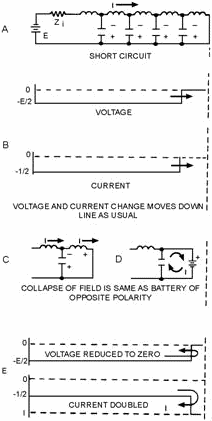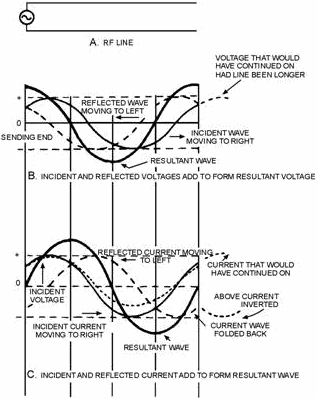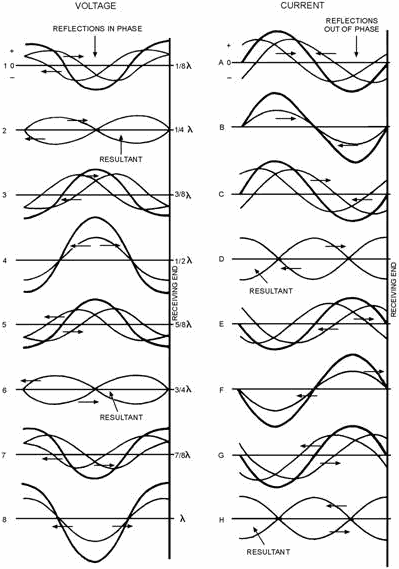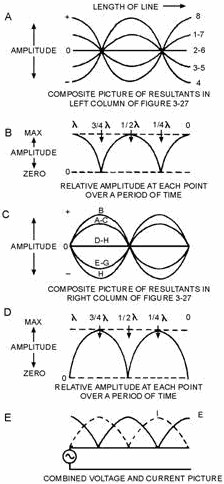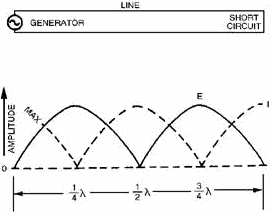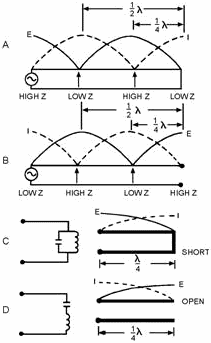Navy Electricity and Electronics Training Series (NEETS) |
||||||||||||||||||||||||||||||||||||||||||||||||||
|
Module 10 − Introduction to Wave Propagation, Transmission Lines, and Antennas
Pages i, 1−1, 1−11, 1−21, 1−31, 1−41, 2−1, 2−11, 2−21, 2−31, 2−40, 3−1, 3−11, 3−21, 3−31, 3−41, 3−51, 4−1, 4−11, 4−21, 4−31, 4−41, 4−51, Index
Figure 3-25. - Reflection from a short-circuited line.
Now there is no voltage to maintain the current through the next to the last inductor. Therefore, this inductor discharges the next to the last capacitor.
As each capacitor is discharged to zero, the next inductor effectively becomes a new source of voltage. The amplitude of each of these voltages is equal to E/2, but the polarity is the opposite of the battery at the input end of the line. The collapsing field around each inductor, in turn, produces a voltage that forces the current to continue flowing in the same direction, adding to the current from the source to make it 2I. This action continues until all the capacitors are discharged (view E).
Reflected waves from a short-circuited transmission line are characterized as follows:
3-31 REFLECTION of AC Voltage FROM an OPEN Circuit
In most cases where RF lines are used, the voltages applied to the sending end are ac voltages. The action at the receiving end of the line is exactly the same for ac as for dc. In the open-ended line, shown in figure 3-26, view A, the generated ac voltage is distributed along the line, shown in view B. This voltage is distributed in such a way that as each instantaneous voltage arrives at the end, it is reflected with the same polarity and amplitude. When ac is used, this reflection is in phase. Each of the reflected voltages travels back along the line until it reaches the generator. If the generator impedance is the same as the line impedance, energy arriving at the generator is absorbed and not reflected again. Now two voltages are on the line.
Figure 3-26. - Formation of standing waves.
View B shows how two waves of the same frequency and amplitude moving in opposite directions on the same conductor will combine to form a resultant wave. The small solid line is moving steadily from left to right and is the INCIDENT WAVE (from the source). The broken-line waveform is moving from right to left and is the REFLECTED WAVE. The resultant waveform, the heavy line, is found by algebraically adding instantaneous values of the two waveforms. The resultant waveform has an
3-32 instantaneous peak amplitude that is equal to the sum of the peak amplitudes of the incident and reflected waves. Since most indicating instruments are unable to separate these voltages, they show the vector sum. An oscilloscope is usually used to study the instantaneous voltages on RF lines.
Since two waves of voltage are moving on the line, you need to know how to distinguish between the two. The voltages moving toward the receiving end are called INCIDENT VoltageS, and the whole waveshape is called the INCIDENT WAVE. The wave moving back to the sending end after reflection is called the REFLECTED WAVE. The resultant voltage curve (view B of figure 3-26) shows that the voltage is maximum at the end of the line, a condition that occurs across an open circuit.
Another step in investigating the open-circuited RF line is to see how the current waves act. The incident current wave is the solid line in figure 3-26, view C. The voltage is represented by the dotted line. The current is in phase with the voltage while traveling toward the receiving end. At the end of the line, the current is reflected in the opposite polarity; that is, it is shifted 180 degrees in phase, but its amplitude remains the same. The reflected wave of current is shown by dashed lines in view C. The heavy-line curve represents the sum of the two instantaneous currents and is the resultant wave. Notice that current is zero at the end of the line. This is reasonable, since there can be no current flow through an open circuit.
Views B and C of figure 3-26 show the voltage and current distribution along a transmission line at a point about 1/8 after a maximum voltage or current reaches the end of the line. Since the instantaneous values are continuously changing during the generation of a complete cycle, a large number of these pictures are required to show the many different relationships.
Figure 3-27 shows the incident and reflected waveshapes at several different times. The diagrams in the left column of figure 3-27 (representing voltage) show the incident wave and its reflection without change in polarity. In figure 3-27, waveform (1), the incident wave and the reflected wave are added algebraically to produce the resultant wave indicated by the heavy line. In waveform (2), a zero point preceding the negative-going cycle of the incident wave is at the end of the line. The reflected wave and incident wave are 180 degrees out of phase at all points. (The reflected wave is the positive cycle that just preceded the negative cycle now approaching the end of the line.) The resultant of the incident and reflected waves is zero at all points along the line. In waveform (3), the waves have moved 1/8λ along the line; the incident wave has moved 45 degrees to the right, and the reflected wave has moved 45 degrees to the left. The resultant voltage, shown by the heavy line, has a maximum negative at the end of the line and a maximum positive 1/2λ from the end of the line.
3-33
Figure 3-27. - Instantaneous values of incident and reflected waves on an open-ended line.
3-34 In waveform (4), the incident wave is at a maximum negative value at the end of the line. The wave has moved another 45 degrees to the right from the wave in the preceding illustration. The reflected wave has also moved 45 degrees, but to the left. The reflected wave is in phase with the incident wave. The resultant of these two waves, shown by the dark line, again has a negative maximum at the end of the line and a positive maximum 1/2λ from the end of the line. Notice that these maxima have a greater amplitude than those in waveform (3).
In waveform (5), the incident wave has moved another 45 degrees to the right and the reflected wave 45 degrees to the left. The resultant again is maximum negative at the end and positive maximum 1/2λ from the end. The maxima are lower than those in waveform (4). In waveform (6), the incident and reflected wave have moved another 1/8λ. The two waves again are 180 degrees out of phase, giving a resultant wave with no amplitude. The incident and reflected waves continue moving in opposite directions, adding to produce the resultant waveshapes shown in waveforms (7) and (8). Notice that the maximum voltage in each resultant wave is at the end and 1/2λ from the end.
Study each part of figure 3-27 carefully and you will get a clear picture of how the resultant waveforms of voltage are produced. You will also see that the resultant voltage wave on an open-ended line is always zero at 1/4λ and 3/4λ from the end of the transmission line. Since the zero and maximum points are always in the same place, the resultant of the incident and the reflected wave is called a Standing WAVE of voltage.
The right-hand column in figure 3-27 shows the current waveshapes on the open-ended line. Since the current is reflected out of phase at an open end, the resultant waveshapes differ from those for voltage. The two out-of-phase components always cancel at the end of the transmission line, so the resultant is always zero at that point. If you check all the resultant waveshapes shown in the right-hand column of figure 3-27, you will see that a zero point always occurs at the end and at a point 1/2λ from the end. Maximum voltages occur 1/4λ and 3/4λ from the end.
When an ac meter is used to measure the voltages and currents along a line, the polarity is not indicated. If you plot all the current and voltage readings along the length of the line, you will get curves like the ones shown in figure 3-28. Notice that all are positive. These curves are the conventional method of showing current and voltage standing waves on RF lines.
Figure 3-28. - Conventional picture of standing waves.
When an RF line is terminated in a short circuit, reflection is complete, but the effect on voltage and current differs from that in an open-ended line. Voltage is reflected in opposite phase, while current is reflected in phase. Again refer to the series of pictures shown in figure 3-27. However, this time the left column represents current, since it shows reflection in phase; and the right column of pictures now represents the voltage changes on the shorted line, since it shows reflection out of phase.
3-35 The composite diagram in figure 3-29 shows all resultant curves on a full-wavelength section of line over a complete cycle. Notice that the amplitude of the voltage varies between zero and maximum in both directions at the center and at both ends as well but, one-fourth of the distance from each end the voltage is always zero. The resultant waveshape is referred to as a standing wave of voltage. Standing waves, then, are caused by reflections, which occur only when the line is not terminated in its characteristic impedance.
Figure 3-29. - Composite results of instantaneous waves.
3-36 The voltage at the center and the ends varies at a sinusoidal rate between the limits shown. At the one-fourth the three-fourths points, the voltage is always zero. a continuous series of diagrams such as these is difficult to see with conventional test equipment, which reads the effective or average voltage over several cycles. The curve of amplitude over the length of line for several cycles is shown in figure 3-29, view B. a meter will read zero at the points shown and will show a maximum voltage at the center, no matter how many cycles pass.
As shown in view D, the amplitude varies along the length of the line. In this case it is zero at the end and center but maximum at the one-fourth and three-fourths points. The entire diagram of the open- ended line conditions is shown in view E. The standing waves of voltage and current appear together. Observe that one is maximum when the other is minimum. The current and voltage standing waves are one-quarter cycle, or 90 degrees, out of phase with one another.
REFLECTION of AC Voltage FROM a Short Circuit
Reflection is complete when an RF line is terminated in a short circuit, but the effect on voltage and current differs from the effect obtained in an open-ended line. Voltage is reflected in opposite phase, while current is reflected in phase. Again look at the series of diagrams in figure 3-27. The left column represents current, and the right column shows voltage changes on the shorted line. The standard representation of standing waves on a shorted line is shown in figure 3-30; the voltage is a solid line, and the current is a dashed line. The voltage is zero at the end and center (1/2λ) and maximum at the 1/4λ and 3/4λ points, while the current is maximum at the end and center and minimum at the 1/4λ and 3/4λ points.
Figure 3-30. - Standing waves on a shorted line.
As we discussed voltage and current waves on transmission lines, we pointed out several differences between open and shorted lines. Basic differences also appear in the standing-wave patterns for open and shorted lines. You can see these differences by comparing figure 3-29, view E, and figure 3-30. Notice that the current and voltage standing waves are shifted 90 degrees with respect to the termination. At the open end of a line, voltage is maximum (zero if there are no losses in the line). At a short circuit, current is maximum and voltage is minimum.
Q23. Two types of waves are formed on a transmission line. What names are given to these waves?
3-37 Q24. In figure 3-27, which waveforms on the left have a resultant wave of zero, and what is indicated by these waves?
Q25. On an open-ended transmission line, the voltage is always zero at what distance from each end of the line?
TERMINATING a Transmission LINE
a transmission line is either NONRESONANT or RESONANT. First, let us define the terms nonresonant lines and resonant lines. a nonresonant line is a line that has no standing waves of current and voltage. a resonant line is a line that has standing waves of current and voltage.
Nonresonant Lines
A nonresonant line is either infinitely long or terminated in its characteristic impedance. Since no reflections occur, all the energy traveling down the line is absorbed by the load which terminates the line. Since no standing waves are present, this type of line is sometimes spoken of as a FLAT line. In addition, because the load impedance of such a line is equal to Z0, no special tuning devices are required to effect a maximum power transfer; hence, the line is also called an UNTuned line.
Resonant Lines
A resonant line has a finite length and is not terminated in its characteristic impedance. Therefore reflections of energy do occur. The load impedance is different from the Z0 of the line; therefore, the input impedance may not be purely resistive but may have reactive components. Tuning devices are used to eliminate the reactance and to bring about maximum power transfer from the source to the line. Therefore, a resonant line is sometimes called a Tuned line. The line also may be used for a resonant or tuned circuit.
A resonant line is sometimes said to be resonant at an applied frequency. This means that at one frequency the line acts as a resonant circuit. It may act either as a high-resistive circuit (parallel resonant) or as a low-resistive circuit (series resonant). The line may be made to act in this manner by either open- or short-circuiting it at the output end and cutting it to some multiple of a quarter-wavelength.
At the points of voltage maxima and minima on a short-circuited or open-circuited line, the line impedance is resistive. On a short-circuited line, each point at an odd number of quarter-wavelengths from the receiving end has a high impedance (figure 3-31, view A). If the frequency of the applied voltage to the line is varied, this impedance decreases as the effective length of the line changes. This variation is exactly the same as the change in the impedance of a parallel-resonant circuit when the applied frequency is varied.
3-38
Figure 3-31. - Sending-end impedance of various lengths and terminations.
At all even numbered quarter-wavelength points from the short circuit, the impedance is extremely low. When the frequency of the voltage applied to the line is varied, the impedance at these points increases just as the impedance of a series-resonant circuit varies when the frequency applied to it is changed. The same is true for an open-ended line (figure 3-31, view B) except that the points of high and low impedance are reversed.
At this point let us review some of the characteristics of resonant circuits so we can see how resonant line sections may be used in place of LC circuits.
A PARALLEL-RESONANT circuit has the following characteristics:
· At resonance the impedance appears as a very high resistance. a loss-free circuit has infinite impedance (an open circuit). Other than at resonance, the impedance decreases rapidly.
A Series-RESONANT circuit has these characteristics:
3-39
Since the impedance a generator sees at the quarter-wave point in a shorted line is that of a parallel- resonant circuit, a shorted quarter-wave- length of line may be used as a parallel-resonant circuit (figure 3-31, view C). An open quarter-wavelength of line may be used as a series-resonant circuit (view D). The Q of such a resonant line is much greater than can be obtained with lumped capacitance and inductance.
Impedance for Various Lengths of Open Lines
In figure 3-32, the impedance (Z) the generator sees for various lengths of line is shown at the top. The curves above the letters of various heights show the relative value of the impedances presented to the generator for the various line lengths. The circuit symbols indicate the equivalent electrical circuits for the transmission lines at each particular length. The standing waves of voltage and current are shown on each length of line.
3-40
|
||||||||||||||||||||||||||||||||||||||||||||||||||
